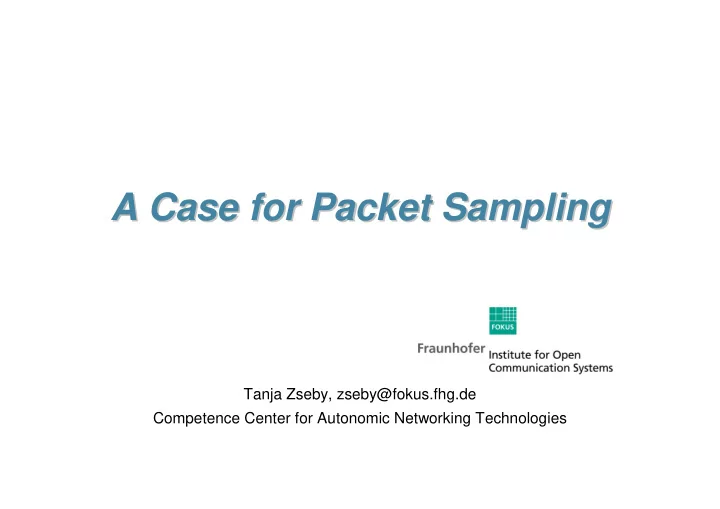

A Case for Packet Sampling A Case for Packet Sampling Tanja Zseby, zseby@fokus.fhg.de Competence Center for Autonomic Networking Technologies
Motivation: FloCon FloCon 2005 2005 Motivation: FloCon05 participants: “We don’t believe in Sampling” � Happy to use flow data � Very skeptical to packet sampling FloCon 2006 Panel 2
The Problem: Limited Resources The Problem: Limited Resources � Full packet capture at each node not feasible – Increasing data rates – Hardware costs Additional CPU load for running NetFlow on different routers* – Privacy concerns � Resources are limited – Storage – Processing – Transmission We cannot measure everything *source: NetFlow Performance Analysis, Cisco white paper http://www.cisco.com/warp/public/cc/pd/iosw/prodlit/ntfo_wpa.jpg FloCon 2006 Panel 3
Solution1: Flow Data Solution1: Flow Data � Grouping of packets into flows (classification) � Reporting of flow information only � Disadvantages: – Per-packet information is lost – Information and effort depends on flow definition Flow Info: 5x 2x 1x Record Generation Classification FloCon 2006 Panel 4
Flow Data Generation Flow Data Generation Traffic Mix: Traffic Mix: <s 1 , t 1 , c 1 >, <s 2 , t 2 , c 2 >, ... <s N , t N , c N > <s 1 , t 1 , c 1 >, <s 2 , t 2 , c 2 >, ... <s N , t N , c N > Classification Classification Flows: Flows: FlowID 1: FlowID 1: FlowID 2: FlowID 2: FlowID 3: FlowID 3: <s 1 , t 1 , c 1 > <s 1 , t 1 , c 1 > <s 2 , t 2 , c 2 > <s 2 , t 2 , c 2 > <s 5 , t 5 , c 5 > <s 5 , t 5 , c 5 > <s 4 , t 4 , c 4 > <s 4 , t 4 , c 4 > <s 3 , t 3 , c 3 > <s 3 , t 3 , c 3 > <s 7 , t 7 , c 7 > <s 7 , t 7 , c 7 > <s 8 , t 8 , c 8 > <s 8 , t 8 , c 8 > <s 6 , t 6 , c 6 > <s 6 , t 6 , c 6 > <s 9 , t 9 , c 9 > <s 9 , t 9 , c 9 > Record Record Record Aggregation Aggregation Aggregation Aggregation Aggregation Aggregation Generation Generation Generation Flow Characteristics: Flow Characteristics: <N f , µ f , f , … > <N f , µ f , f , … > <N f , µ f , f , … > <N f , µ f , f , … > <N f , µ f , f , … > <N f , µ f , f , … > � Information about packets is discarded � Available information depends on – Flow definition – Flow characteristics that are reported FloCon 2006 Panel 5
Solution2: Packet Sampling Solution2: Packet Sampling � Random Selection of some packets – Report parts or full packet information – Estimation of metrics based on sample � Provides different viewpoint – Packet data can reveal further information – Sampled data sufficient for some metrics � Helps to protect measurement infrastructure during attack Packet Inspection Sampling FloCon 2006 Panel 6
Sampling: State of Art Sampling: State of Art attack detection as protect infrastructure target application First Sampling sFlow Workshop DDos detection IPFIX PSAMP 2005 [RFC3176] flow volume stratified adaptive sample+hold [Zseb05] [EsKM04] [EsVa01] load change detection SLA/QoS (trajectory) ATM hash emulation proportion stratified [DuGr00] [NiMD04], [MoND05] [CoGi98] [Zseb02] [Zseb03] anomaly detection with hypothesis testing total volume flow sampling adaptive time vs. count [DuLT01] [ChPZ02] [ClPB93] packet-count per flow 2-run adaptive [KoLM04] [JePP92] [DrCh98] packet-count [AmCa89] 1990 1995 2000 2001 2002 2003 2004 2005 FloCon 2006 Panel 7
Packet Sampling Packet Sampling Real metric substituted by estimate � Accuracy statement is essential Accuracy depends on – Sampling scheme – Estimation method – Position of sampling process in measurement sequence – Population characteristics (e.g. variance of metric of interest) FloCon 2006 Panel 8
A Simple Example A Simple Example Goal: Estimation of packet proportions (e.g. TCP-SYN packets in a flow) m M = ˆ = P P Estimate: Real proportion: N n ( ) ⋅ − − P 1 P N n σ = ⋅ Estimation Accuracy (random n-of-N): − ˆ P n N 1 ( ) − ⋅ σ ≤ ≤ + ⋅ σ = − α ˆ ˆ Prob P z P P z 1 Confidence Limits: ˆ ˆ c c P P Example: - Measurement interval with N=10,000 packets - Random packet selection 1% (n=100) σ = P = ˆ � 0.8226 � P � 0.977, with 99% confidence � 0.03 0.9 ˆ P P = ˆ � same accuracy 0.1 σ = � 0.371 � P � 0.629, with 99% confidence P = ˆ (worst case) � 0.05 0.5 ˆ P Works with other packet properties, too! FloCon 2006 Panel 9
Advise Advise � Don’t restrict your analysis to flow data – Include further viewpoints – Use sampling in addition or as alternative to flow data � Trust the power of statistics – It’s a mature and well established field � full range of proven techniques � Use sampling where applicable – Applicability depends on traffic profile, metric of interest, accuracy demand � Sampled data sufficient to detect large events (high volumes, high packet counts) � May be sufficient to estimate #pkts with specific properties (e.g. SYN, VoIP packets, small packets, packets with same content, etc.) � Others � depends on scenario – Difficulties with rare events (stealth attacks, slow port scans) – Not suitable to re-assemble connections (but filtering may be) FloCon 2006 Panel 10
Thank you for your Thank you for your attention! attention!
Recommend
More recommend